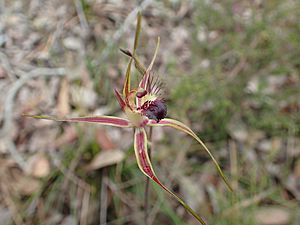Karri spider orchid facts for kids
Quick facts for kids Karri spider orchid |
|
|---|---|
 |
|
| Caladenia brownii in the Mount Frankland National Park | |
| Scientific classification | |
| Genus: |
Caladenia
|
| Species: |
brownii
|
The Karri spider orchid (scientific name: Caladenia brownii) is a special type of orchid plant. It grows only in the south-west part of Western Australia. This unique orchid has a hairy leaf and can have up to three colorful flowers. Its flowers are a mix of red, green, white, and yellow. You can find it in the tall karri forests and along the coast in areas that get a lot of rain. It's the only spider orchid that grows in karri forests!
Contents
What Does the Karri Spider Orchid Look Like?
The Karri spider orchid is a ground-growing plant. It is also a perennial plant, which means it lives for many years. It's a deciduous plant, losing its leaves at certain times. It has an underground tuber, which is like a storage root.
It grows a single, hairy leaf that is about 10 to 25 cm (4-10 inches) long. This leaf is about 5 to 10 mm (0.2-0.4 inches) wide. The plant can have up to three flowers on a stem. This stem can be 20 to 60 cm (8-24 inches) tall.
The flowers are quite large, about 7 to 10 cm (3-4 inches) long and 4 to 5 cm (1.6-2 inches) wide. They show off a mix of red, green, white, and yellow colors. The side parts of the flower, called sepals and petals, spread out wide. They have thin, red glands on their tips that make a scent.
The central part of the flower is called the labellum. It is greenish-yellow with a red tip. The sides of the labellum have long, thin teeth or "calli." There are also four or more rows of red calli along the middle of the labellum.
Life Cycle and Flowering
The Karri spider orchid usually flowers between October and early December. After the flowers bloom, they form a dry seed pod. This pod is called a capsule. It opens up to release many tiny seeds.
How it Got its Name
The scientific name Caladenia brownii was first officially described in 2001. Two scientists, Stephen Hopper and Andrew Brown, named it. They published their description in a science journal called Nuytsia. The second part of the name, brownii, honors Andrew Brown. He was the one who found the very first plant specimen used for the description.
Where Does the Karri Spider Orchid Live?
The Karri spider orchid grows in forests, woodlands, and coastal areas. It likes places that get a lot of rain. You can find it between Dunsborough and Albany in Western Australia. It is special because it is the only Caladenia orchid that grows in the tall karri forests.
Is the Karri Spider Orchid Safe?
The Western Australian Government's Department of Parks and Wildlife has looked at the Karri spider orchid. They have classified it as "not threatened." This means it is not currently in danger of disappearing.

